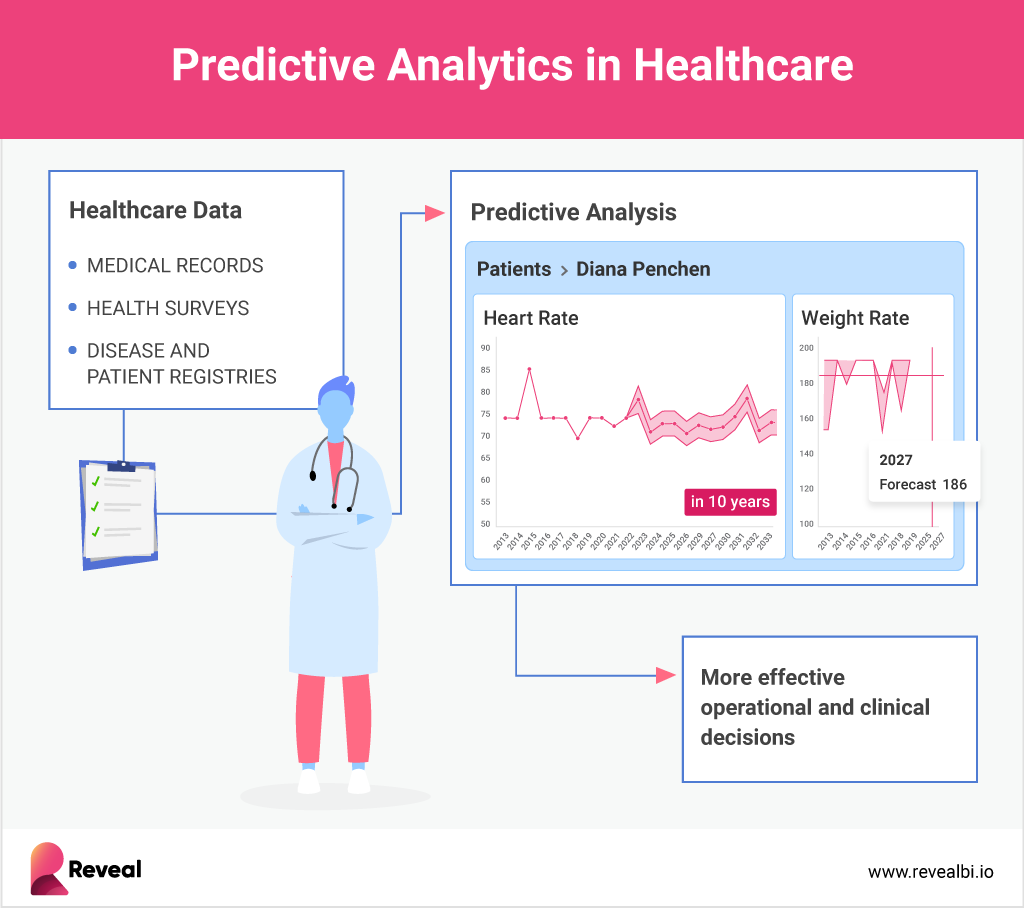Predictive analytics is a game-changer for the healthcare industry. By leveraging data-driven insights and predictive models, we can anticipate potential issues before they emerge, better understand patient needs, and swiftly spot health trends.
Imagine if your doctor could predict health risks before they manifested. Or if you could receive early warning signals for conditions like cancer or heart disease. Thanks to predictive healthcare analytics and technologies like machine learning, this is now becoming a reality. It’s a revolution that’s making healthcare smarter, more efficient, and more attuned to patients’ needs.
Personalized healthcare organizations are increasingly moving from basic analytics to predictive health insights to better navigate current challenges and anticipate outcomes. Instead of just presenting historical data, predictive analytics provides a forecast based on key findings from the past. This forward-thinking approach enables clinicians, financial analysts, and administrative staff to anticipate potential situations and make informed decisions about future actions.
The value of predictive modeling in healthcare is particularly noticeable in emergency care, surgery, and intensive care. In these areas, swift responses and informed decision-making can significantly impact patient outcomes.

So, what exactly is predictive analytics in healthcare?
It’s a process that uses past healthcare data to identify patterns and trends that could hint at future events. It can be used to predict the likelihood of specific health conditions, clinical decisions, trends, or even the spread of diseases.
By leveraging predictive analytics, healthcare providers can make more informed decisions about treatments and how best to adapt them to individual patients’ needs. They can also identify patients at risk of complications or relapses and provide early interventions. Ultimately, predictive analytics holds the potential to enhance the quality and efficiency of healthcare delivery.
Predictive analytics is an indispensable tool for healthcare organizations. It allows them to make better-informed decisions, uncover hidden opportunities in their data, and make accurate diagnoses swiftly. Even insurance companies are turning to predictive analytics to gain deeper insights into customer behavior.
Using predictive analytics, healthcare has become more efficient, reliable, and cost-effective. From improved diagnostics to better resource management, predictive analytics is making healthcare more streamlined and effective, hence its growing popularity among healthcare providers.
Unpacking the potential of predictive analytics: real-world examples
Predictive analytics in healthcare is being used in multiple ways, allowing organizations to glean actionable insights from their ever-growing healthcare data.
Predictive modeling can help identify individuals at increased risk of developing chronic diseases early on, helping them dodge costly and difficult health issues. Similarly, the use of predictive analytics enables companies to pinpoint patients likely to require frequent care or treatment, improving risk management and easing the transition to value-based care.
In the hospital setting, predictive modeling can help medical professionals respond quickly to changes in a patient’s vitals and detect symptom deterioration before it becomes overt. Predictive tools can also alert providers when a patient’s risk factors indicate a high likelihood of readmission, preventing frequent hospital returns.
Predictive analytics can even identify patients likely to miss an appointment, thereby mitigating gaps in the daily schedule and reducing financial repercussions for healthcare organizations.
Moreover, predictive analytics can support chronic disease management strategies and aid in designing effective communication and compliance strategies. A notable example includes Anthem, who used predictive modeling to create consumer profiles and tailor messaging for patients.
Potential use-cases
- Improved Quality of Care: Predictive analytics uses historical data to predict the best course of action and treatment plan for individual patients, thereby improving the quality of care. An example includes a system at James Cook University, which utilizes a Neonatal Artificial Intelligence Morality Score (NAIMS) to determine the best course of treatment for premature infants.
- Chronic Disease Management: Predictive analytics also plays a pivotal role in managing chronic diseases by leading to quicker diagnoses and efficiently evaluating the effectiveness of a treatment plan. For example, an app developed at the University of Michigan uses AI and predictive analytics to detect early signs of Alzheimer’s disease.
- Preventing Disease Onset: Predictive analytics is also used to identify environmental risk factors to prevent the onset of chronic diseases. For instance, Mount Sinai researchers developed tools to predict risk factors that could trigger Crohn’s disease.
- Forecasting Disease Spread: Predictive analytics has been invaluable in managing the COVID-19 pandemic by helping track and prepare for the virus’s spread. For example, researchers at the University of Texas Health Science Center developed a COVID-19 tracking tool that uses predictive modeling.
- Anticipating Future Healthcare Trends and Events: Predictive analytics helps anticipate future health events and trends that impact clinical care delivery, like the rise of alcohol-related liver disease in the US as suggested by a study published in the Lancet Public Health.
- Decision-Making Process: Predictive analytics also aids in the medical decision-making process. It can predict mortality rates for patients in ICU, enabling doctors to make resource allocation decisions quickly, which is crucial for saving lives.
In conclusion, predictive analytics is quickly becoming a vital tool for today’s healthcare organizations. It offers improved diagnostics, care quality, and reduced costs, among other benefits. As a still evolving field, there is ample scope for further research and development. But one thing is clear – the potential of predictive analytics to enhance the quality and efficiency of healthcare delivery is tremendous.
Subscribe to my weekly newsletter!
References:
- https://healthitanalytics.com/news/blood-testing-predictive-analytics-determine-covid-19-severity
- https://healthitanalytics.com/news/predictive-analytics-tool-accurately-detects-patient-deterioration
- https://www.projectpro.io/article/how-to-build-arima-model-in-python/544
- https://www.projectpro.io/article/predictive-analytics-in-healthcare-projects/732
- https://theappsolutions.com/blog/development/predictive-analytics-in-healthcare/
- https://itrexgroup.com/blog/predictive-analytics-in-healthcare-top-use-cases/
- https://www.forbes.com/sites/forbestechcouncil/2023/02/21/the-crucial-role-of-predictive-analytics-in-precision-medicine/
- https://www.foreseemed.com/predictive-analytics-in-healthcare

